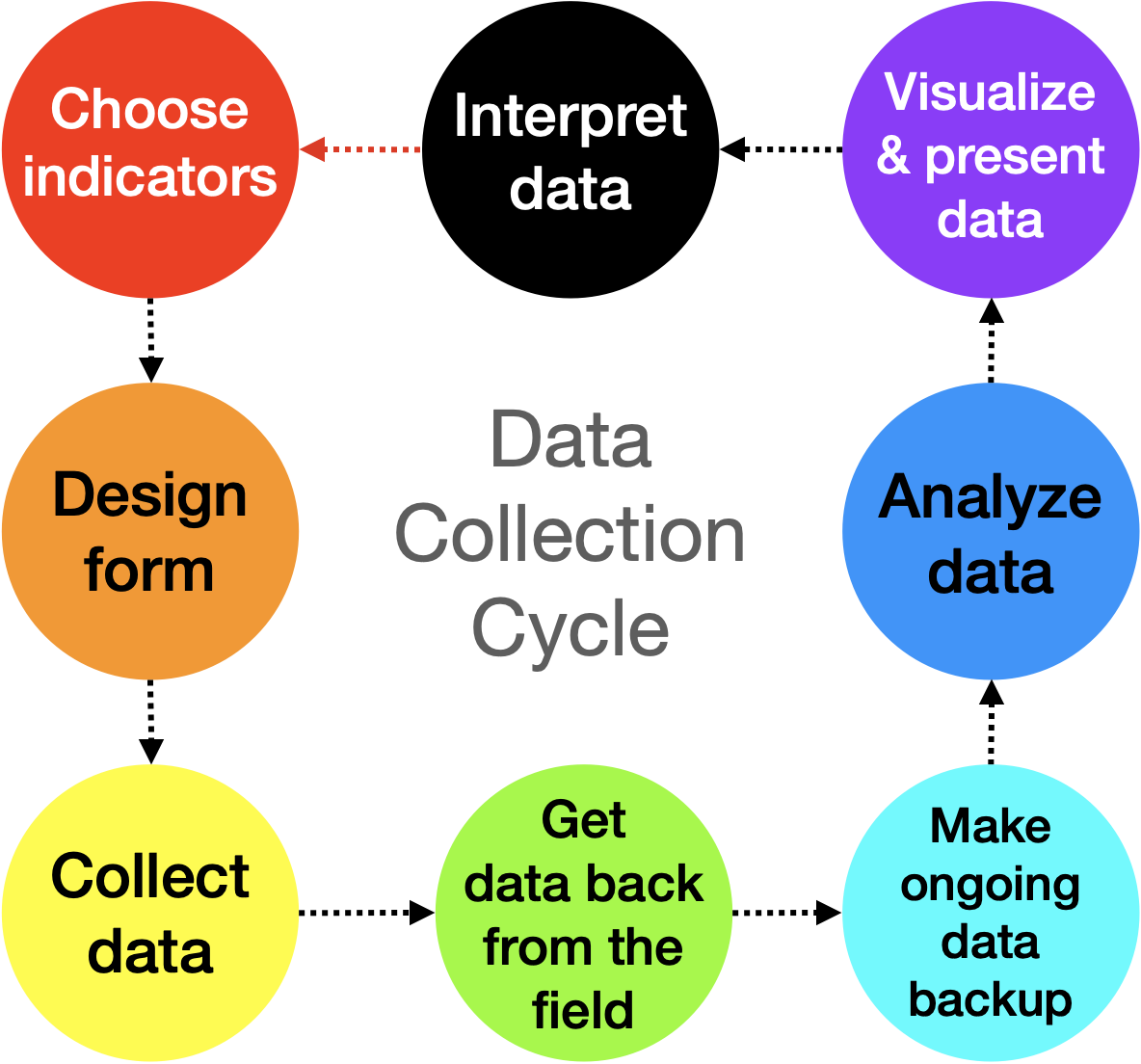Data management in monitoring and evaluation is a widely-used practice within a number of industries and sectors, including humanitarian assistance. This data management can involve a wide variety of activities, including data collection on relevant indicators, analysis of the collected data, and a reporting system to ensure that the properly analyzed data is seen by key people at every level. For many programs, these activities make up a repeating cycle that enable reliable data to inform continuously improving programmatic activities:
All these activities must have a responsible person or — more commonly — persons, typically including those with expertise in
identifying appropriate indicators
designing a data collection form to allow the accurate collection of those indicators in the field
getting that data collection form into an electronic system (e.g. a mobile phone or tablet)
moving the collected data into a data management space for cleaning and analysis
managing the dataset and ensuring that there are multiple backup copies
analyzing the collected data
interpretation, visualization and presentation of collected data
And a project manager, or primary investigator, to manage the entire process.
For data management in monitoring and evaluation, the development of computers, mobile phones, and cloud-based systems has been a godsend: streamlining, speeding up, and/or automating a very wide variety of data management tasks. Nonetheless, no automation has replaced the need for subject matter expertise: the knowledge of what indicators are important, how best to design questions and integrate them into forms, and what the reporting system will look like. As with an automobile, it can take you places faster than walking, but you need to know where you want to go!
Happily, if you do know where you want to go, systems like Magpi — developed back in 2003 as the first cloud-based system for mobile data collection in the global health and international development sector — can take you there faster than ever before. Magpi, and its many imitators, have eliminated the need for programmers or other IT staff in order for knowledgeable data managers to get their work done efficiently and quickly.
Deploying Mobile Electronic Forms
As one example, the process of getting the appropriate form questions into an electronic system used to involve multiple IT specialists: server technicians to install the appropriate software on server computers, coders to program the questions into electronic form, just for a start. This meant that data management in monitoring and evaluation was a time-consuming, and money-consuming, process.
Nowadays, though, anyone with the ability to use basic tools like Gmail or MS Word can easily create combine questions into a complete electronic form in minutes. They can then push that form onto tens, hundreds, or thousands of mobile phones and tablets . . . automatically! No photocopying, no IT specialist. Once the data manager has indicated which field staff are to have access to a form — usually by entering/uploading their email addresses — those staff members will receive the form immediately (or as soon as they are online). What’s more, any subsequent changes to the form will also be pushed automatically to those same staff members with zero effort on the part of the data manager.
Recovering data from the field
Just as forms automatically deploy to designated staff, as data is collected it is automatically uploaded to the web-based Magpi system. If the field staff are in a remote area, or their battery dies, or they otherwise can’t find a cell signal, the system will wait until the situation improves and will then upload all the data. With no effort on the part of the data collectors or the data manager.
What a difference from how the process worked only a few years ago!
Backing up data
One of the most important aspects of data management in monitoring and evaluation, and one of the most often neglected, is backing up datasets. It’s hard to imagine, but a busy data manager might simply forget to create or update a backup copy of the data collected with such effort in the field — or might create a backup copy on the same laptop as the original copy! — and lose the dataset to technical difficulties or even theft.
This is why it’s so important to use an online system like Magpi, which builds data security (and privacy) into the system from the start. Data uploaded to the Magpi system is backed up invisibly and automatically at least once per day. Even better, Magpi Pro and Enterprise users can, with just a few clicks (and zero programming), set up an automatic backup from Magpi to Microsoft Excel or Google Sheets so that every bit of data uploaded is automatically copied to the Excel or Google spreadsheet. Set it and forget it: a data manager’s dream.
What are you waiting for?
If this all sounds impossible, or expensive, or unlikely to you . . . we’d like nothing more than to show you how Magpi can make your life easier with these features (and much more, like integrating with your existing systems and generating automatic reports). And at a price that makes sense. Data management in monitoring and evaluation is a complex and demanding occupation, but we can make it just a bit easier for you.
We love the chance to convince skeptics, so challenge us!






